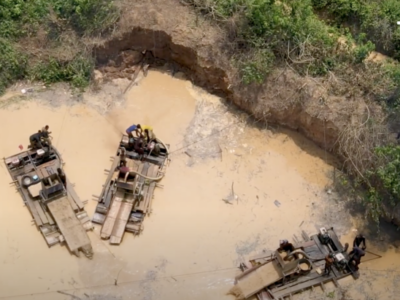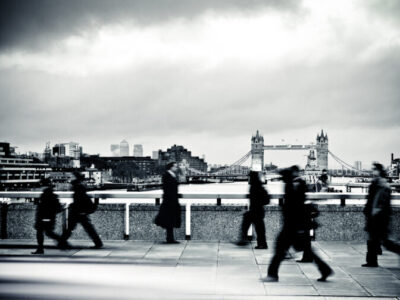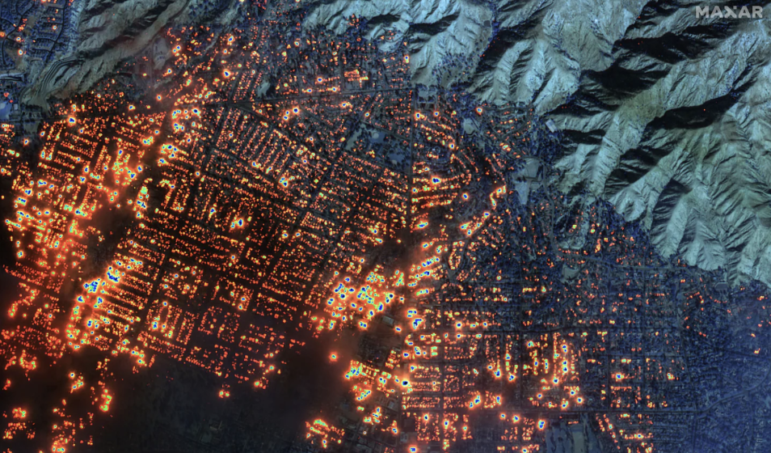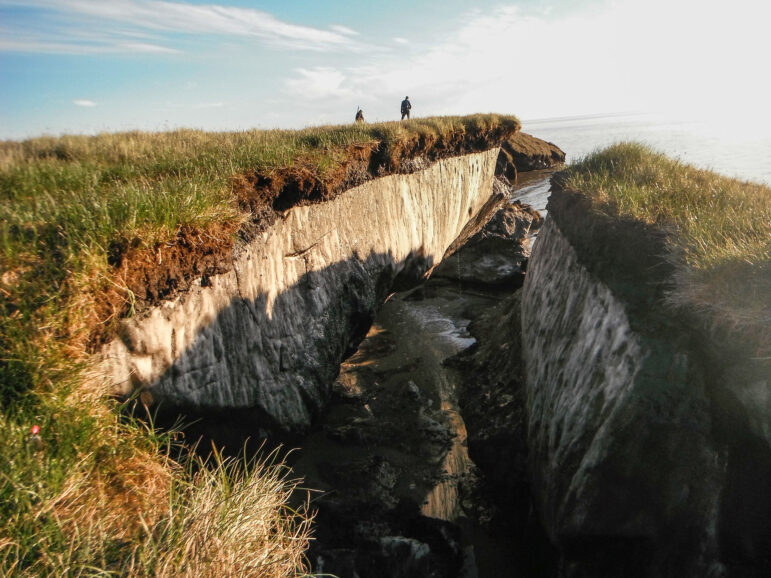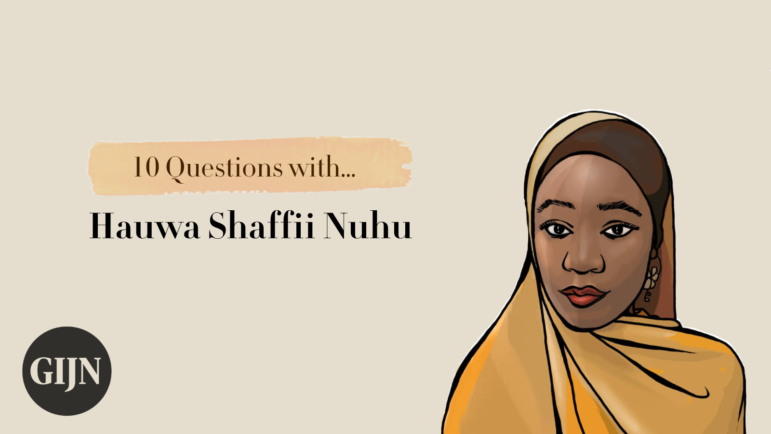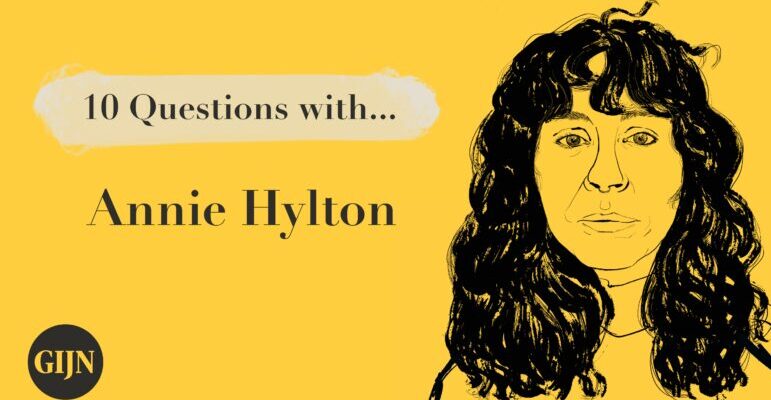
Award-winning Canadian investigative journalist Annie Hylton originally trained as a lawyer focused on humanitarian law and human rights. Hoping to spend time in the field doing deep research, her work increasingly took her down a more academic path and she found herself dissatisfied with “sitting behind a computer.”
A trip to Lebanon 10 years ago, in the midst of hundreds of thousands of Syrians fleeing their country and across the border, changed things, allowing her to explore writing and journalism. “I had never done these things before on my own and I threw myself into it with no idea what I was doing,” she says. “But I realized that this was the kind of work I wanted to do, to immerse myself in communities and to travel and explore the world, while also exposing under-the-radar wrongdoing and harm.”
She graduated from Columbia University’s Stabile Center for Investigative Journalism in New York in 2016, and her byline can now be found on deeply reported stories for publications including the Guardian, The New Yorker, and Harper’s. Her reporting and investigative work frequently focuses on what is sometimes called “chapter two stories,” which she explains as “the idea that when all of the cameras and news outlets have left a place, a community, or a story, what’s left behind? What stories are not being told?”
With this approach in mind, her investigations have covered a wide range of topics, including the aftermath of the Srebrenica massacre in Bosnia and Herzegovina 25 years on, the search for unmarked graves of Indigenous children in Canada, and how Parisians helped house refugees during the COVID-19 pandemic. Her latest investigation looks at the plight of the members of Afghanistan’s national women’s soccer team, who still remain in the country years after promises from the Canadian government that they would be allowed to immigrate and avoid living under Taliban rule. She is the recipient of multiple grants, fellowships, and awards, including a 2018 NYU Reporting Award that supported reporting on North Korean refugees and defectors. She also teaches investigative journalism at Sciences Po in Paris, France.
GIJN: Of all the investigations you’ve worked on, which has been your favorite and why?
Annie Hylton: I try to invest in projects that I believe in, so it’s sort of hard to pick a favorite, also, because most of them involve deep human suffering. But I think one of my most fascinating, most stimulating projects that I worked on was related to Syrian war criminals in Europe. I found it intellectually stimulating and rewarding, because it took me across Europe, into people’s homes, but also into bureaucratic and law enforcement institutions. It embodies my favorite type of story, which is one that involves deep research and document hunting with in-depth human elements and storytelling.
I find it fascinating and haunting that somebody could flee torture and abuse by state actors and then come across their perpetrator among their community or in their neighborhood. I think I was able to make that phenomenon that was sort of under-the-radar a little more public, at least as it related to Syria.
GIJN: What are the biggest challenges in terms of investigative reporting in your country or region?
AH: I work across regions, but in terms of challenges common to the types of investigations I work on, there’s such a disparity in terms of how robust access-to-information laws are and how much they’re enforced. In North America, for instance, it’s much easier to sue for documents or to even request access to them; whereas in Europe, the process is so much more archaic and challenging. You can’t rely on that process to be fruitful. Obviously that’s the case in more developing countries as well, so that’s a real challenge.
There is the challenge of threats, of course, as a woman who works independently, both to my physical being, but also defamation and libel. I do often find that reputational and safety threats are gendered. I need to ensure I work with outlets and publications that cover those issues if I do end up being sued, which is becoming rarer and harder to find.
GIJN: What’s been the greatest hurdle or challenge that you’ve faced in your time as an investigative journalist?
AH: One of the things I find really challenging is sort of a throughline in a lot of the projects that I work on, especially because I’m not among the breaking news teams and the people who are sort of first on the scene, is working with people who become disenchanted or even retraumatized by the media and who don’t trust reporters. Having to work through that and establish trust and a rapport with people can be really difficult.
The only way I’ve been able to surpass those obstacles has been to practice obtaining meaningful consent and having tools related to trauma-informed interviewing practices, which I was lucky enough to learn really early on in my career. That type of interviewing really flips conventional reporting style on its head. You talk to people as if they are participants and walk them through what your project entails and what their role would be. I think that establishes a level of trust because people see very clearly that you’re sincere, what your intentions are, where the story will end up, and what it will look like. It builds mutual trust.
It involves more upfront time investment and it’s not always successful, but it’s my biggest takeaway when it comes to working with communities who have either been impacted by reporting that’s been unethical or who have faced trauma – or both. It’s about establishing that you’re not in a combative relationship, that it’s really participatory
GIJN: What is your best tip or trick for interviewing?
AH: One of the things I try to be conscious of when interviewing is physical space and also how you position yourself with someone. I usually try to let people choose where they place themselves and then put myself wherever there’s room. I think that it’s something that can often be overlooked when you’re in an enclosed space or an unfamiliar – or even a familiar – setting.
If it’s someone who is more like an official or it’s a more traditional interview, I try to meet them in a place that might have visual elements that relate to the story I’m working on. For other people who might be more central subjects, I always try to meet them at home. I think it establishes a level of comfort and it’s a more intimate experience. You can work in personal artifacts and also obtain sourcing that might otherwise not be available, like diaries, notes, or cards. People will show you what their son wrote to them or they might have a file of physical documents gathered over the last 10 years that has no electronic version. I think it’s always the ideal.
GIJN: What is a favorite reporting tool, database, or app that you use in your investigations?
AH: I use Scrivener. Because I like to be very focused on narrative and building a story from the material that I’ve gathered, it helps me distill it and also categorize and kind of separate it into different chapters. It has many advanced tools that I don’t really know how to use, but I can use it to put everything in the same place and then really work through building a narrative, because it allows you to add every physical source or transcript or whatever into different files or chapters or sections. I know a lot of people who use it for book writing, but I use it for long pieces. Sometimes I can have thousands of pages of material and it helps to be able to search through those and to see how to build out from what you have.
GIJN: What’s the best advice you’ve gotten thus far in your career and what words of advice would you give an aspiring investigative journalist?
AH: The idea of “chapter two” stories was shared with me by a mentor. Having that visual is really helpful for me. I think it applies in general to more investigative and long-term work, where you’re looking at the harm or impact of a policy, a law or the adverse effect of some event, where you have to go back. Sometimes it’s many, many years later.
The other piece of advice passed down through one of my mentors, is to “do the chron” [for chronology]. Most of the best investigative reporters I know build the chronology of events, maybe in a Word document, an Excel sheet, or in Scrivener, taking either the main skeleton of the story or the subject and building out a history of events. You build it so you can see overlaps and patterns, actors, and key dates. It’s also incredibly useful when you do the writing, because you have this visual overview of the story and where the plot points and points of interest might have occurred.
In terms of tips for an aspiring journalist and something that I’ve also received as advice: it doesn’t really matter how explosive or important your findings are if you can’t tell a story. Craft is everything. If you don’t have craft, your story won’t reach the right people. The impact is going to be totally lost if people can’t get through the material or the message.
I learned to read the best investigative journalism and writing out there and to deconstruct the journalists I admire. What are each of the sections laid out in the story? What does each of them serve? What elements are included in them? Deconstruct the building blocks of a successful story and then either try to emulate that or model it in a way that works for you. Know the story you’re trying to tell.
GIJN: Who is a journalist you admire, and why?
AH: Several of the tips I’ve mentioned come from [The New Yorker] journalist Sarah Stillman. I think she’s really the best of my generation and she’s the embodiment of everything I believe in as a journalist. She conducts deep, committed work that’s so thoughtful and human and affects change. As a human being, she practices what she preaches and does such tireless, painstaking, gorgeous work and is constantly pushing innovative ways to use data and documents to tell the most beautiful human stories. She’s created an investigative journalist lab at Yale University where she and her students work on investigative projects too.
I’ve also been watching Forensic Architecture from afar grow into one of the most impactful and respected organizations; they use innovative and cutting-edge methods to expose state and corporate human rights violations, shedding light on events that occurred as far back as a century ago. From ecocide to war crimes to arms exports, it’s inspiring me to rethink what’s possible in the realm of investigative journalism. One of its partners, Earshot, is another example of how technology can break new ground to reveal wrongdoing and fill the gaps of impunity — it conducts sonic investigations to deduce new information on perpetrators who fired gunshots or conducted airstrikes, for instance, and has been groundbreaking in its coverage of the war in Gaza.
GIJN: What is the greatest mistake you’ve made and what lessons did you learn?
AH: I think that my biggest challenge is investing too much, for too long, in a story that isn’t going anywhere — not because it doesn’t have legs, but because nobody wants to publish it. The biggest difficulty with that, apart from the disappointment of having put in so much time, is having to tell people who have also invested time in it that it’s going nowhere. It’s especially hard if they’re the ones who are central to the harm that you’re trying to expose or reveal.
I always try to be upfront about the fact that as a freelancer and investigative journalist you don’t always know where things are going to go. You are clear about your hopes and what your aim is, but I’ve learned along the way that the biggest mistake is to make promises. It’s unethical to promise people that your story will do XYZ, because nobody can predict that, but also just to temper expectations about what is even possible or what it might result in. It’s so key, because then people are just participating, either because it’s a cathartic experience for them or because they’re hoping that with the time and energy you put in that it will lead to something but they know there are risks involved.
GIJN: How do you avoid burnout in your line of work?
AH: I don’t. I’m fully exposed all the time, just with my own emotions and the things that I care about. That’s obviously both good and bad. Good in the sense that I keep my humanity and that’s what I care about most, but I’m so bad at knowing my limitations and what I can and can’t handle. That has led to some pretty serious burnout situations. I try really hard to be mindful of when I notice signs that those patterns might be repeating.
One of the things I do is take care of myself physically. I also lean on colleagues to talk through things that I find difficult, disturbing, or overwhelming. Having a community can really help. Both of these things are key. The first is self care — I hate that term — [but] I will not, unless it’s absolutely necessary, compromise my workouts or getting certain food or coffee. Those are things that help me get through my day and it’s important for those to be established.
GIJN: What about investigative journalism do you find frustrating, or do you hope will change in the future?
AH: The very frustrating thing for me is that you have so many talented young people and students who are interested, motivated, and determined to get into investigative work, which is really key to a democracy and holding the powerful to account, but there are so few opportunities and resources put into investigative work in newsrooms and dwindling outlets that focus on this type of work. It’s frustrating for me too to find outlets and publications that really value this kind of long-term, committed work and compensate for it fairly.

